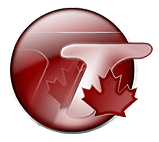TERMIUM Plus
| TERMIUM Plus | |
|---|---|
 | |
| Established | 1976 |
| Jurisdiction | The Translation Bureau of Public Works and Government Services Canada |
| Website |
www |
TERMIUM Plus® is an electronic terminological database operated and maintained by the Translation Bureau, under the Government of Canada. The database offers millions of English and French terms from various specialized fields. Terms in Spanish and Portuguese are also available in the multilingual database.
History
TERMIUM Plus® was initially developed by the Université de Montréal in October 1970.[1] The database, initially named Banque de Terminologie de l’Université de Montréal (BTUM), was under the direction of Marcel Paré, with a vision to produce the most flexible bilingual language file that would be available to all.[2] BTUM was initially funded by private donors and government subsidies, and it grew with the help of professionals in the field of translation over the following years.[3] In 1975, the BTUM was able to obtain data and user responses in collaboration with the language services of Bell Canada.[4]
At the end of 1974, however, the Translation Bureau under the Canadian Secretary of State Department showed interest in the operation of BTUM.[5] The goal of the Translation Bureau at the time was to standardize terminology throughout the public service, as well as the federal public administration.[6] In January 1976, the Canadian Secretary of State Department officially acquired BTUM, and renamed the database TERMIUM (TERMInologie Université de Montréal).[7] The system was then transferred to the central computer of the federal government in Ottawa, and began to integrate approximately 175,000 files that the BTUM initially compiled with the files that the Translation Bureau had been working on.[8] In the years to follow, the bureau began the sorting process, along with the input process onto the computer. The database grew to 900,000 records by 1987.[9]
Development
As terminological records grew in the TERMIUM database, the Canadian government received a proposal, in 1985, from a Toronto-based company to launch TERMIUM in a CD-ROM format, in order to make the database more accessible to users.[10] By fall of 1987, a pilot project for CD-ROM was launched to investigate the responses from its users, which included services under the Translation Bureau and other private Canadian companies.[11] After some data compilation and investigation, the bureau incorporated an indexing system to improve the speed and accuracy of term extraction.
By 1990, TERMIUM on CD-ROM was commercially available through subscription (with an annual fee of $1,100 to $1,500).[12] Updates were released every three to four months.[13] In 1996, TERMIUM on CD-ROM received an award from ATIO (The Association of Translators and Interpreters of Ontario).
Since October 2009, TERMIUM Plus® and an array of language tools under the Language Portal of Canada were launched with free online access.
Features
TERMIUM was initially developed to contain terminological records in both of Canada’s official languages (English and French).[14] As the system upgraded to its third-generation version in 1985, it contained records in other languages such as Spanish, in order to accommodate its growing range of users.[15] It is worth noting, however, that in these “multilingual” records, the term in the source language would be in English or French, with its equivalent in a non-official language.[16]
Currently, there is a vast collection of specialized domains and fields covered by TERMIUM Plus, ranging from administration (including appellations), arts, sciences to law and justice.
Aside from the millions of entries recorded by TERMIUM Plus, the database also contains writing tools for both the English and French language (such as The Canadian Style—a writing style guide, and Dictionnaire des cooccurrences, a guide to French collocations), archived glossaries, as well as a link to the Language Portal of Canada (containing various French and English writing resources).
Notes
- ↑ Gagnon 1994, p. 509
- ↑ Gagnon 1994, p. 509
- ↑ Gagnon 1994, p. 509
- ↑ Gagnon 1994, p. 509
- ↑ Dupont 1989, p. 594
- ↑ Adshead 1987, p. 235
- ↑ Gagnon 1994, p. 509
- ↑ Gagnon 1994, p. 509
- ↑ Gagnon 1994, p. 509
- ↑ Dupont 1989, p. 595
- ↑ Dupont 1989, p. 595
- ↑ Gagnon 1994, p. 512
- ↑ Gagnon 1994, p. 512
- ↑ Gagnon 1994, p. 510
- ↑ Andersen 1987, p. 111
- ↑ Adshead 1987, p. 237
References
- Adshead, Mariam (October 1986). "TERMIUM: The Canadian Government Linguistic Data Bank". Computer and Translation. 1 (4): 235–238.
- Andersen, Aldean; Bergeron, Marie; Dupuis, Gilbert; Leonhardt, Christine; Marrotte, Jean-François; Moritz, Rita (1987). "La creation d'une banque de terminologie et perspectives d'avenir en terminotique". Meta: Translators’ Journal. 32 (2): 111–123.
- DuPont, Sylvie. (1989). "La mise sur DOC d’une banque de données linguistiques : l’exemple de TERMIUM". Meta: Translators' Journal 34 (3): 594-596.
- Gagnon, René. (1994). "Les grandes banques de terminologie". Meta: Translators' Journal 39 (3): 498-520.
- "Government of Canada announces launch of its Language Portal and free access to TERMIUM Plus® for all Canadians". Government of Canada. Archived from the original on 2009-10-08. Retrieved 2015-12-01.
- "1996 ATIO Award". The Association of Translators and Interpreters of Ontario (ATIO). Retrieved 29 November 2015.